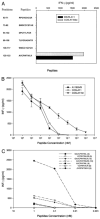T cells associated with tumor regression recognize frameshifted products of the CDKN2A tumor suppressor gene locus and a mutated HLA class I gene product
- PMID: 15128789
- PMCID: PMC2305724
- DOI: 10.4049/jimmunol.172.10.6057
T cells associated with tumor regression recognize frameshifted products of the CDKN2A tumor suppressor gene locus and a mutated HLA class I gene product
Abstract
The dramatic tumor regression observed following adoptive T cell transfer in some patients has led to attempts to identify novel Ags to understand the nature of these responses. Nearly complete regression of multiple metastatic melanoma lesions was observed in patient 1913 following adoptive transfer of autologous tumor-infiltrating lymphocytes. The autologous 1913 melanoma cell line expressed a mutated HLA-A11 class I gene product that was recognized by the bulk tumor-infiltrating lymphocytes as well as a dominant T cell clone derived from this line. A second dominant T cell clone, T1D1, did not recognize the mutated HLA-A11 product, but recognized an allogeneic melanoma cell line that shared expression of HLA-A11 with the parental tumor cell line. Screening of an autologous melanoma cDNA library with clone T1D1 T cells in a cell line expressing the mutated HLA-A11 gene product resulted in the isolation of a p14ARF transcript containing a 2-bp deletion in exon 2. The T cell epitope recognized by T1D1, which was encoded within the frameshifted region of the deleted p14ARF transcript, was also generated from frameshifted p14ARF or p16INK4a transcripts that were isolated from two additional melanoma cell lines. The results of monitoring studies indicated that T cell clones reactive with the mutated HLA-A11 gene product and the mutated p14ARF product were highly represented in the peripheral blood of patient 1913 1 wk following adoptive transfer, indicating that they may have played a role in the nearly complete tumor regression that was observed following this treatment.
Figures




References
-
- Robbins PF, Wang RF, Rosenberg SA. Tumor antigens recognized by cytotoxic lymphocytes. In: Sitkovsky MV, Henkart PA, editors. Cytotoxic Cells: Basic Mechanisms and Medical Applications. Lippincott Williams & Wilkins; Philadelphia: 2000. p. 363.
-
- Ikeda H, Lethe B, Lehmann F, van Baren N, Baurain JF, de Smet C, Chambost H, Vitale M, Moretta A, Boon T, Coulie PG. Characterization of an antigen that is recognized on a melanoma showing partial HLA loss by CTL expressing an NK inhibitory receptor. Immunity. 1997;6:199. - PubMed
-
- Hanada K, Perry-Lalley DM, Ohnmacht GA, Bettinotti MP, Yang JC. Identification of fibroblast growth factor-5 as an overexpressed antigen in multiple human adenocarcinomas. Cancer Res. 2001;61:5511. - PubMed
-
- Wolfel T, Hauer M, Schneider J, Serrano M, Wolfel C, Klehmann-Hieb E, De Plaen E, Hankeln T, Meyer zum Buschenfelde KH, Beach D. A p16INK4a-insensitive CDK4 mutant targeted by cytolytic T lymphocytes in a human melanoma. Science. 1995;269:1281. - PubMed
MeSH terms
Substances
Grants and funding
LinkOut - more resources
Full Text Sources
Other Literature Sources
Molecular Biology Databases
Research Materials
Miscellaneous

